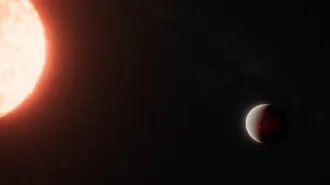A comet discovered last January just can’t keep itself together. Ever since astronomers first spied the object, dubbed C/2001 A2, it’s been breaking up.
The first sign that the comet might be undergoing some kind of upheaval came in March, when the body suddenly brightened. Brightening is often a sign of a cometary breakup, which exposes new surfaces to sunlight and vents trapped ice and gas that are then illuminated by the sun.
Observations in early April revealed that the comet had split in two. By mid-May, images taken with one of the quartet of 8.2-meter telescopes, known as the Very Large Telescope, in Paranal, Chile, revealed that one of the two halves had itself split in half. Researchers reported the finding in a May 17 circular of the International Astronomical Union (IAU).
In mid-June, the comet fragments brightened again, and observers at the European Southern Observatory in La Silla, Chile, found three new chunks. They reported their find in a July 5 IAU circular.
The comet made its closest approach to Earth on June 30, when it came within 30 million km. It remains visible with binoculars and may continue to brighten and crumble.
Such breakups aren’t just an observational curiosity. When comets spill their guts, these frozen relics from the birth of the solar system reveal their origin and their composition.
For instance, when another comet shattered into more than 10 pieces as it neared the sun last summer (SN: 8/12/00, p. 103), astronomers gleaned new clues about its makeup. That comet, now designated C/1999 S4, as well as C/2001 A2, were discovered by the Lexington, Mass.based team of astronomers known as LINEAR (for Lincoln Near Earth Asteroid Research).
In the May 18 Science, scientists reported that C/1999 S4 is the first comet whose ratio of deuterium to hydrogen is similar to that found in water on Earth. This could revive the idea that comets were the source of at least some of our planet’s water.







